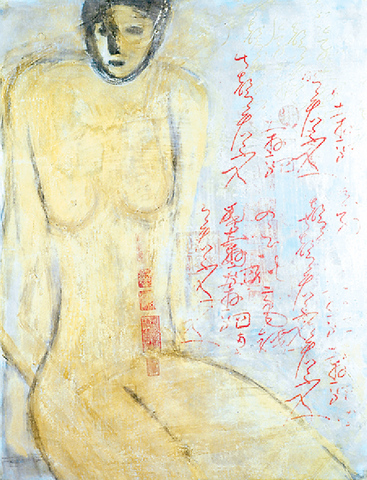The farewell party for Club 75 yesterday marked the end of Patrick Lee's (李紹榮) days as a club proprietor, freeing up his schedule to pursue art full time. Only a few hours before he closed the bar on Saturday night Lee held an opening for his latest solo exhibition, Simply Symbols at Jeff Hsu's gallery in Taipei.
He studied finance at University and worked in the bar and restaurant industry for over a decade. Never formally trained in art, Lee has been painting since he was 10 years old. Although he treats it more like a hobby, his work generates a sizeable revenue. It is especially popular in Europe where his most recent exhibit at a gallery in Copenhagen, Denmark sold every piece.
The 25 works on display are a continuation of a style Lee has been working with in the last five years. In his words it's a combination of "east and west." In this case the east is illustrated by calligraphy and Chinese symbols while the nude female silhouettes represent the west, or more accurately the western influence on his work.

PHOTO COURTESY OF THE ARTIST
The ink stokes used to paint the female figure and the choice of red, black, white and gold colors are characteristic of Chinese brush painting. The calligraphy and chop markings that cover the body compliment the figure. A few of the images invoke memories of Peter Greenaway's The Pillow Book, in which a woman seeks lovers who will use her body like a canvas to write on. The women in Lee's paintings are often without any facial features, and sometimes even without heads. The anonymity gives them a nondescript yet indisputably feminine shape.
The larger pieces are completed on canvases while the smaller pieces use a wooden surface. Both utilize acrylic and oil paints together with metallic powder, silk-screening and calligraphy. The combination is not excessive and the paintings retain a minimalist appearance. The layers of materials create depth and texture, which is more visible in the wooden canvases.
Lee's new work is a major departure from his earlier paintings in the early 1990s that focused on abstract western landscapes. The introduction of Chinese motifs into his work is more recent. Neither the symbols nor the images are imbedded with hidden explanations, according to Lee, who described them as a blend of Chinese and European influences. "There are simply symbols with no hidden meaning," he said.
Each of the works is aesthetically pleasing to look at on its own, but overall the exhibition has a commercial feel. Strong impressions from an individual painting are weakened by the fact that there are 20 other similar ones surrounding it.
What is exceptional, however, is the way Lee made use of the space. An otherwise plain cement room has been transformed with a few Buddhist relics and four large standing red lamp tables to look like a lounge bar. It's possible to assess how and why these artworks would be popular in a club space. Likewise, it's easy to see Lee's interest and eye for interior design.
Exhibition notes:
What: `Simply Symbols: The Solo Exhibition of Patrick Lee'
Where: Jeff Hsu's Art (
Telephone: (02) 8780 8181
When: The exhibition runs until March 27. The gallery is open daily from 11am to 7pm but closed on Mondays.

The Democratic Progressive Party (DPP), Chinese Nationalist Party (KMT), and the country’s other political groups dare not offend religious groups, says Chen Lih-ming (陳立民), founder of the Taiwan Anti-Religion Alliance (台灣反宗教者聯盟). “It’s the same in other democracies, of course, but because political struggles in Taiwan are extraordinarily fierce, you’ll see candidates visiting several temples each day ahead of elections. That adds impetus to religion here,” says the retired college lecturer. In Japan’s most recent election, the Liberal Democratic Party lost many votes because of its ties to the Unification Church (“the Moonies”). Chen contrasts the progress made by anti-religion movements in

Taiwan doesn’t have a lot of railways, but its network has plenty of history. The government-owned entity that last year became the Taiwan Railway Corp (TRC) has been operating trains since 1891. During the 1895-1945 period of Japanese rule, the colonial government made huge investments in rail infrastructure. The northern port city of Keelung was connected to Kaohsiung in the south. New lines appeared in Pingtung, Yilan and the Hualien-Taitung region. Railway enthusiasts exploring Taiwan will find plenty to amuse themselves. Taipei will soon gain its second rail-themed museum. Elsewhere there’s a number of endearing branch lines and rolling-stock collections, some

Last week the State Department made several small changes to its Web information on Taiwan. First, it removed a statement saying that the US “does not support Taiwan independence.” The current statement now reads: “We oppose any unilateral changes to the status quo from either side. We expect cross-strait differences to be resolved by peaceful means, free from coercion, in a manner acceptable to the people on both sides of the Strait.” In 2022 the administration of Joe Biden also removed that verbiage, but after a month of pressure from the People’s Republic of China (PRC), reinstated it. The American

This was not supposed to be an election year. The local media is billing it as the “2025 great recall era” (2025大罷免時代) or the “2025 great recall wave” (2025大罷免潮), with many now just shortening it to “great recall.” As of this writing the number of campaigns that have submitted the requisite one percent of eligible voters signatures in legislative districts is 51 — 35 targeting Chinese Nationalist Party (KMT) caucus lawmakers and 16 targeting Democratic Progressive Party (DPP) lawmakers. The pan-green side has more as they started earlier. Many recall campaigns are billing themselves as “Winter Bluebirds” after the “Bluebird Action”